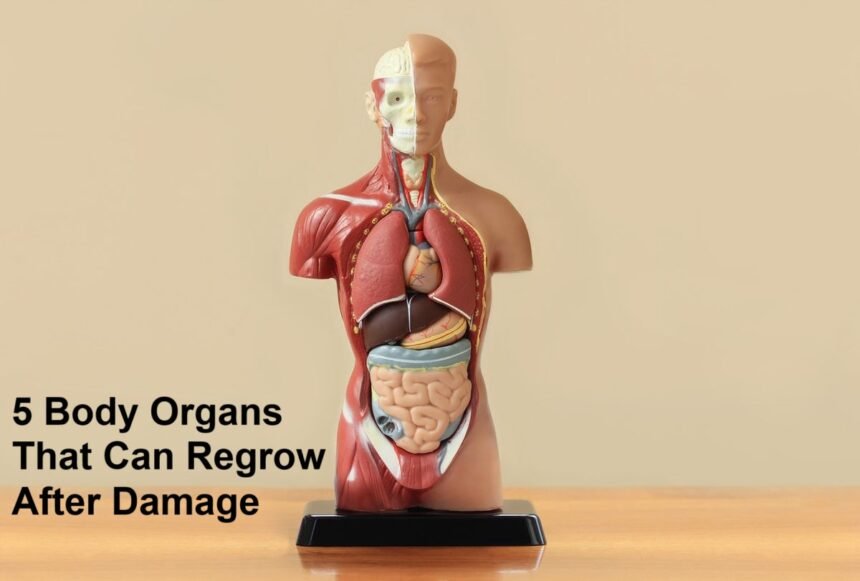Introduction
The human body is a marvel of biological engineering, capable of remarkable feats of repair and regeneration. While many organs have limited regenerative abilities, some can actually grow back after injury or damage, helping maintain overall health and functionality. Understanding which organs can regenerate is not only fascinating but also vital for medical science, offering hope for treatments and regenerative therapies. Here are five body organs that have the remarkable ability to grow back after damage.
1. Liver
The liver is arguably the most famous regenerative organ in the human body. It plays a crucial role in detoxification, metabolism, and nutrient storage. What makes the liver truly extraordinary is its ability to regenerate tissue after injury or surgical removal.
Studies show that the liver can regenerate up to 70% of its tissue in response to damage or partial removal (hepatectomy). This regenerative process involves the proliferation of existing liver cells called hepatocytes. Within weeks, a liver that has been damaged or partially removed can regrow to its original size and function, provided that the underlying cause of damage is addressed.
This regenerative capacity is vital in medical procedures like liver transplants, where a portion of a donor’s liver is transplanted into a recipient. Both the donor’s and recipient’s livers regenerate to normal size over time, highlighting the liver’s extraordinary ability to heal itself.
2. Skin
While often considered an organ, the skin is the body’s largest barrier against external threats such as bacteria, chemicals, and injuries. It is also highly regenerative, capable of repairing itself after cuts, burns, or abrasions.
Skin regeneration occurs primarily through the proliferation of keratinocytes, the predominant cell type in the epidermis. When the skin is injured, these cells migrate to the wound site, multiply, and eventually restore the skin’s protective barrier. This process can happen rapidly, often completing within weeks for small injuries.
Chronic wounds or severe burns, however, can impair this regenerative ability, sometimes leading to scarring or incomplete healing. Nonetheless, the overall regenerative capacity of skin is impressive and vital for maintaining the body’s integrity.
3. Intestines
The lining of the intestines, particularly the small intestine, has a high turnover rate and is constantly regenerating. The epithelial cells lining the intestinal walls renew approximately every 4-5 days, driven by stem cells located in structures called crypts.
This rapid regeneration is essential because the intestines are exposed to harsh digestive enzymes, acids, and a vast microbial community, all of which can cause damage over time. The regenerative process maintains the intestine’s integrity and functionality, enabling it to absorb nutrients effectively.
Furthermore, this regenerative ability makes the intestine a target for therapies in conditions such as inflammatory bowel disease (IBD) and chemotherapy-induced damage. Researchers are exploring ways to harness this natural regeneration to develop regenerative medicine approaches.
4. Blood Vessels
Blood vessels—including arteries, veins, and capillaries—also possess a remarkable ability to regenerate after injury. When damaged due to trauma, surgery, or disease, the body activates processes such as angiogenesis—the formation of new blood vessels—to restore blood flow and tissue health.
This process involves the proliferation and migration of endothelial cells, the cells lining blood vessels, which create new pathways for blood. This capacity is vital for wound healing, recovery from heart attacks, and the body’s response to ischemic conditions.
Understanding vascular regeneration has profound implications for treatments of cardiovascular diseases. Medical research is investigating ways to stimulate blood vessel growth to repair damaged tissues and improve circulation in affected organs.
5. Bone
Finally, bones are highly regenerative organs, capable of healing and regrowing after fractures or injuries. Bone regeneration involves a complex process where precursor cells develop into osteoblasts—cells responsible for new bone formation.
When a bone breaks, the body naturally initiates healing through three overlapping stages: inflammation, bone production, and bone remodeling. Over several weeks to months, depending on the fracture’s severity, the bone can heal completely, restoring its strength and function.
Advancements in orthopedic treatments, such as bone grafts and stem cell therapies, aim to enhance this natural regenerative process, especially in cases where healing is complicated by age, disease, or severe injury.
Conclusion
While not all organs in the human body can regenerate, these five—liver, skin, intestines, blood vessels, and bones—demonstrate the remarkable capacity for self-repair. Their regenerative abilities play a vital role in maintaining health, healing injuries, and enabling medical breakthroughs. Ongoing research into these natural processes continues to inspire innovative therapies and treatments, offering hope for improved recovery and regeneration in various medical conditions.












